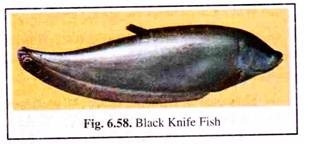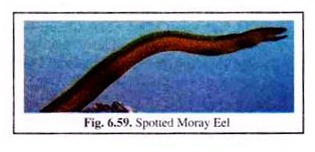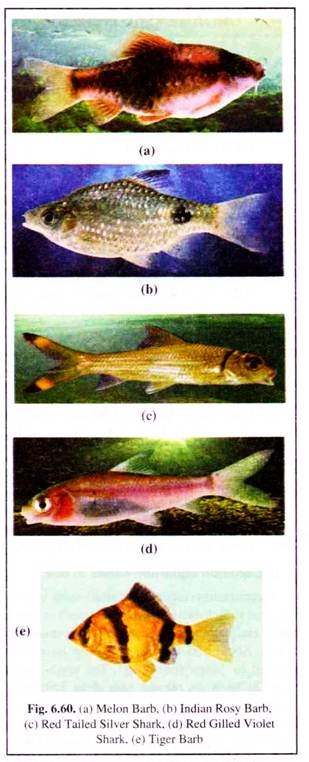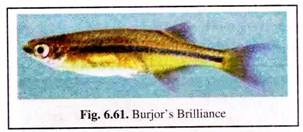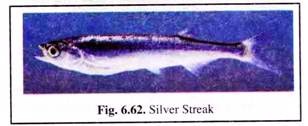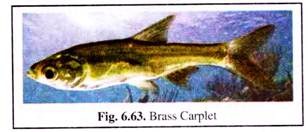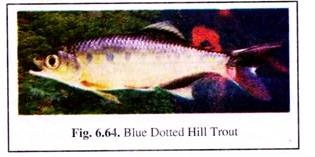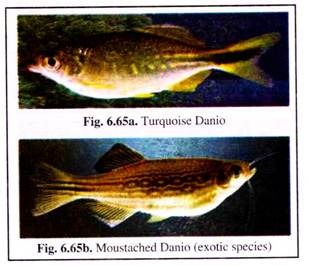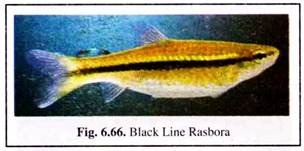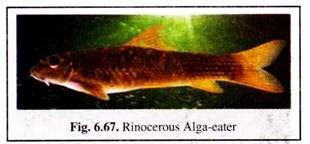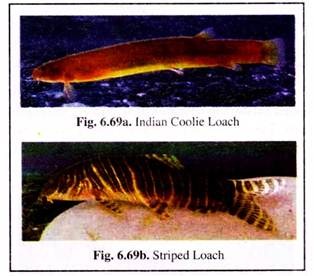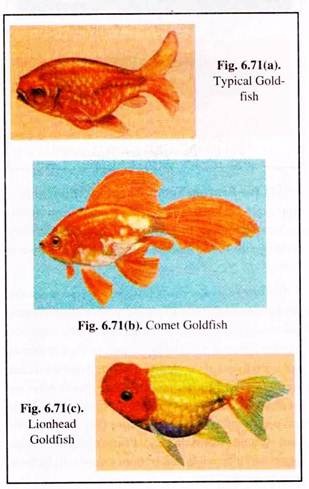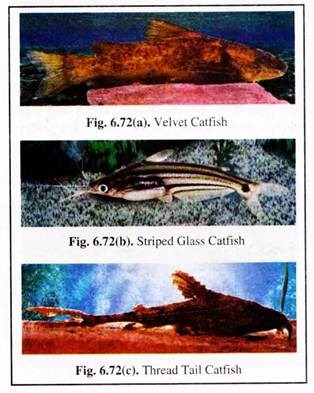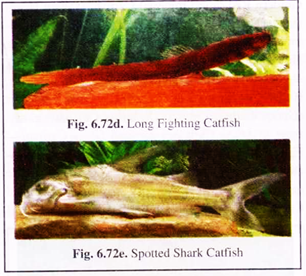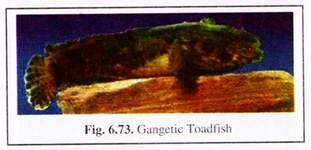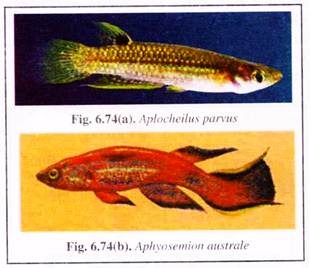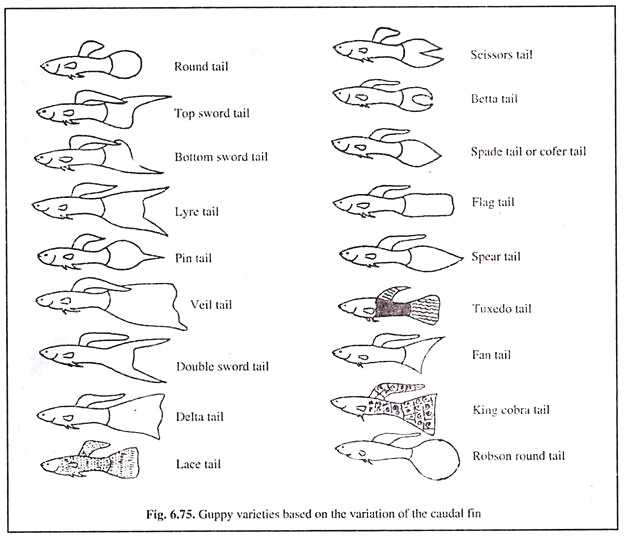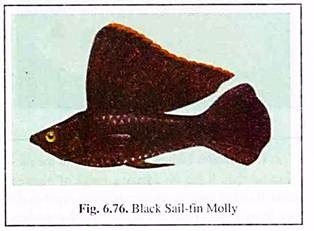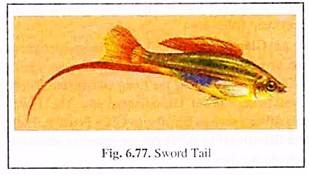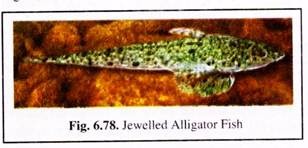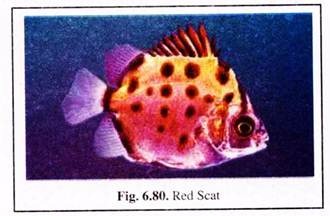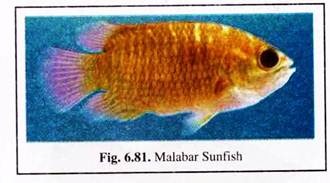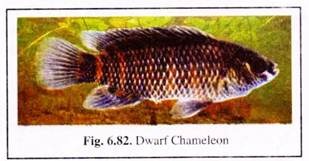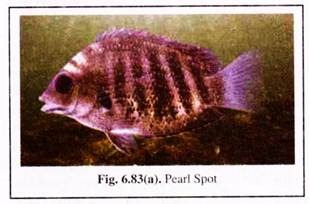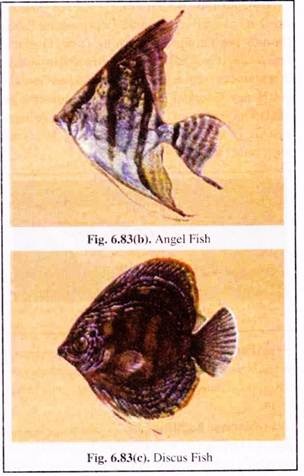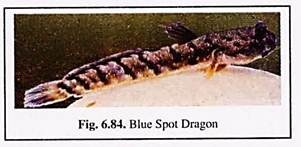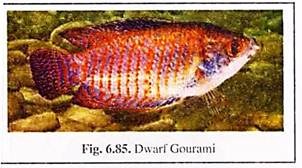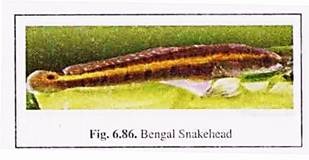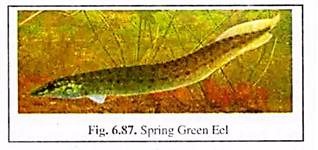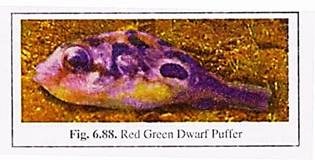List of thirty-four commonly used fishes for aquarium:- 1. Knife Fishes 2. Eel 3. Barbs 4. Hatchet Fishes 5. Razorbelly and Streak 6. Carplets 7. Trouts 8. Danios 9. Rasbora 10. Alga-Eater 11. Torrent Fish 12. Loaches 13. Characins 14. Goldfishes 15. Catfishes 16. Toadfishes 17. Halfbeaks 18. Killifishes or Egg-Laying Tooth Carps 19. Live-Bearing Tooth-Carps 20. Sea Horses and Pipe Fishes and Others.
1. Knife Fishes:
The family Notopteridae under this order Osteoglossiformes has two species in India and are known as featherbacks. They are easily identified by their long anal fin and a small slender dorsal fin (for which the name ‘Featherback’).
The aquarists, however, call these fishes as ‘Knife Fishes’— the Clown Knife fish which is larger and the Black Knife fish which is smaller (Fig. 6.58). Due to their graceful movements they are perfect for display in public aquaria. They are predatory in nature and if kept with small sized fishes in aquaria, will devour it.
2. Eel:
The order Anguilliformes consists of the well-known Eels. They are catadromous fishes. They are highly valued as food fishes. There are some species of eels which are priced by aquarists, such as the spotted Moray Eel (Fig. 6.59), Pink Worm Eel, Olive Eel, Brown Snake Eel and Bicolour Snake Eel.
3. Barbs:
This group are economically important both as food and aquarium fishes. It comprises Hi-Fin Barbs and the true barbs. The true barbs previously under the genus Barbus is now limited only to the African and European species. In the Asiatic region the Genus name Puntius is used.
There is hardly any freshwater body in the Indian region which does not have this species. Some popular Puntius species from India are the Golden Dwarf Barb (also known as Gelius Barb), Melon Barb [Fig. 6.60(a)], Four Spot Barb.
Two Spot Barb, Green Swamp Barb, Indian Rosy Barb (Fig. 6.60(b)], Long Snouted Barb, Black Spot Barb, Filament Barb, Malini’s Barb, Golden Dwarf Barb, Streaked Barb, Dwarf Barb. Maharaja Barb, Sophore’s Barb. One spot Barb: Tic-Tac-Toe Barb, Kooli Barb. Red Line Torpedo Fish, DMK Fish.
Other types of Barbs are under the following Genus:
(i) Thick lip under the genus Catla.
(ii) White Carps under the genus Cirrhinus
(iii) Red Tailed Silver Shark [Fig. 6.60(c)] under the genus Gonoproktopterus. This genus also consists the Scarly Barb and Sombre Barb.
ADVERTISEMENTS:
(iv) Sharks under the genus Labeo. All species of Labeo introduced into the aquarium trade were all known popularly as sharks.
They comprise of the following:
1. Red Tail Black Shark (Labeo bicolour). This is the native of Thailand. From this fish the nickname ‘shark’ was obtained for these groups (Labeo) of aquarium fishes. However, now Labeo bicolour is known as Epalzeorhynchus bicolour.
2. Red Gilled Violet Shark (Labeo boga). This strikingly beautifully coloured fish [Fig. 6.60(d)] has emerged as a hot favourite with aquarists all over the world.
3. Black Line Shark (Labeo bata).
4. Syke’s Shark (Labeo boggut)
5. All Black Shark (Labeo calbasu).
6. Miniscale Shark (Labeo gonius).
7. Southern Orange Shark (Labeo kontius).
ADVERTISEMENTS:
(v) Other aquarium fishes under genus Labeo are:
(i) Silver Labeo (Labeo kawrus)
(ii) Pencil Gold Labeo (Labeo nandina)
(vi) Tiger Barb (Puntius tetrazona) is one of the most colourful active aquarium fish from Indonesia [Fig. 6.60(e)). It is yellow with black stripes across the body.
4. Hatchet Fishes:
These fishes belonging to the Genus Chela are also commonly known as ‘oriental white minnows’. There are 4 species in India — Neon Hatchet (Chela cachius), Burjor’s Brilliance (Chela dadiburjori, Fig. 6.61), Indian Glass Hatchet (Chela labuca) and Malabar Hatchet.
5. Razorbelly and Streak:
They belong to the genus Salmostoma. Razorbelly is a silvery, elongated fish. The streak comprises Long Jawed Streak and the Silver Streak (Fig. 6.62). The Long Jawed Streak is regarded as a useful larvivorous fish.
6. Carplets:
The carplets are represented by the Veli Lake Carplet and the most popular (among aquarists) Brass Carplet (Fig. 6.53). These fishes are under the genus Amblypharyngodon and inhabit the Indus plain and the adjacent hilly areas. Glowlight carplet of the genus Horadandia is one of the smallest aquarium fishes found in India measuring 1 cm.
7. Trouts:
These are mostly present in the hill or mountain streams but a few inhabit low land water. 17 species are found in the Indian region comprising Blue Dotted Hill Trout (Fig. 6.64). Branded Hill Trout, Metallic Hill Trout, Lineated Hill Trout, Spotted Hill Trout, Half Banded Hill Trout, the very rare Milk-fish with its silvery, milky appearance, etc.
8. Danios:
The Danios belonging to the genus Danio has derived its name from the Bengali word ‘dhani’. This name probably refers to their small size or to their habitat in paddy (paddy in Bengali is called ‘dhan’) fields, in the edges of rivers and lakes in grassy jungles.
There are 11 species in India comprising Turquoise Danio (Fig. 6.65a), Zebra Danio, Giant Danio, Malabar Danio, etc. The exotic Moustached Danio (Fig. 6.65b) has a characteristic two pairs of long barbs.
The Dwarf Danios are from the genus Brachydanio which has eight species in the Indian region.
9. Rasbora:
These cyprinids of the genus Parlu- ciosoma (Slender Rasbora, Black Line Rasbora — Fig. 6.66, etc.) have 9 species and the genus Rasbora (Yellow Tail Black Tip, Yellow Tail Scissorstail, etc.) comprises 4 species.
10. Alga-Eater:
The alga-eaters of genus Crosso- cheilus (Slaty Alga-eater) have two species in India. They are boring but are an excellent algae- and refuse- eater. The alga-eaters of genus Garra have 19 species in the Indian region.
They are adapted to life in swift-flowing mountain streams. The Rinocerous Alga-eater (Fig. 6.67) is much sought after fish by the aquarists. Other known ones are cardamom Alga- eater, Kemp’s Alga-eater, Khasi Alga-eater, Cauvery Alga-eater, Brown Alga-eater, etc.
11. Torrent Fish:
There are 5 hill stream species of Torrent fishes in India of the genus Psilorhynchus. Notable among them are the Banded Torrent Fish (Fig. 6.68), checkered Torrent Fish and Sparkling Torrent Fish.
12. Loaches:
Loaches are a varied group of aquarium fishes belonging to 2 families (Balitoridae and Cobitidae), 4 sub-families and 45 genera.
It comprises Sucker Loaches, Cylindrical Loaches, Wedge Tail Loaches, Puma Loach, Sidewinder Loach, Fascinating Loach, Zodiac Loach, Leopard Loach, Black Panther Loach, Air Breathing Loaches, Snake Loaches or Indian Coolie Loach (Fig. 6.69a), Ring Loach, Olivaceous Loach, Polka Dotted Loach, Banded Loaches, Victory Loach, Long Snouted Loach, Grizzled Loach, Tail Spot Loach, Goalpara Loach, Jaguar Loach, Y-Loach, Tiger Loach, Striped Loach (Fig. 6.69b), etc. The last named three Loaches are the most popular among the Indian Loaches.
13. Characins:
Characterised by the possession of either teeth or an adipose fin. A number of these fishes from South America are known as the ‘tetras’ such as Lemon Tetra. Rosy Tetra, Bleeding Heart Tetra, Red Tetra. Neon Tetra (Fig. 6.70), etc. Other groups of characins are the Beacon Fish or Head-and- tail-Light Fish, X-Ray Fish. etc.
14. Goldfishes:
These exotic cyprinids are very much in demand in the ornamental fish market. A number of fancy varieties of goldfishes are available in the market, such as the common or typical goldfish Carassius auratus, Fig. 6.71(a); Comet Gold- fish [Fig. 6.71(b)] has very long caudal fin; Veitail Goldfish has all the fins greatly elongated and is golden in colour; Shubunkin Goldfish has colours of deep blue, red and white, black and golden; Lionhead Goldfish [Fig. 6.71(c)] has expanded and warty head.
Other varieties of Goldfishes are Peacock tail, Oranda, Calico Oranda, Telescope Eyes, Calico, Fringetail, etc.
15. Catfishes:
Generally catfishes can be identified by the presence of barbels on each side of the upper jaw and some also have on the lower jaw. These fishes are priced as food item and are very numerous in the Indian sub-continent.
Many catfishes are said to be venomous. With the help of their spines they can inflict severe wounds and inject a poison produced by the glandular epidermal cells. The catfishes of aquarium value comprise 13 families and 54 genera.
Some notable aquarium catfishes are:
(i) Bagrid Catfishes comprising the magnificent Goldern Red-tailed Imperial Catfish, Golden Head- stander Catfish, Velvet Catfish [Fig. 6.72(a)], Shovel- mouth Catfishes, Shark Catfishes, Mystus Catfishes, Hovering Catfishes, Whale Catfishes (Genus Rita), etc.;
(ii) Eurasian Catfishes comprising Glass Catfish, Butter Catfishes (Gulper Catfish), Killer Catfishes (Genus Wallago), etc;
(iii)Schilbid Catfishes consisting of Glass Catfishes (striped Glass Catfish — Fig. 6.72(b), etc.;
(iv) Scissorstail Catfishes;
(v) Sisorid Catfishes contain the Thread Tail Catfish endemic to India [Fig. 6.72(c)]. Torrent Catfishes, Flat -Headed Catfishes, Broad-Headed Catfishes, Whiptail Catfishes, etc.
(vi) Air breathing Catfishes (Clarius);
(vii) Stinging Catfishes of the genus Heteropneustes:
(viii) Angler Catfishes are robust but ugly to look at, such as the Devil Catfish;
(ix) Stream Catfishes;
(x) Tiger Shark Catfishes:
(xi) Fighting Catfishes have elongated body and no two specimens can be kept in a single aquarium Ex. Long Fighting Catfish [Fig. 6.72(d)];
(xii) Sea Catfishes are primarily marine with few being confined to freshwaters. Examples are the Dusky Shark Catfish, Spotted Shark Catfish [Fig. 6.72(e)], etc.;
(xiii) Eel Tail Catfishes occur in marine, brackish and freshwaters.
16. Toadfishes:
There are only two genera of this fish in India. The Gangetic Toadfish (Fig. 6.73) makes a grunting sound when disturbed. Handling must be done with care as its spine can inflict injury.
17. Halfbeaks:
Famous among them are the Southeast Asian Halfbeak and the Long Nose Needlefish.
18. Killifishes or Egg-Laying Tooth Carps:
They are small fishes and are excellent jumpers. They are egg hangers (eggs are laid on floating plants) or egg-buriers (eggs are burried in the bottom).
Some egg-hangers are Rivulus cylindraeus from Cuba and Florida; Aplocheilus lineatus and A. parvus Fig. 6.74(a) of Indian origin and Aphyosemion australe Fig. 6.74(b) and A. gardneri form West Africa have become extremely popular in recent years because of their beautiful colours.
Among the egg-buriers are the Dwarf Argentine Pearlfish (Cynolebias nigripinnis), Aphyosemion sjoestedti, Rachovia brevis, Roloffia occidentails, etc.
19. Live-Bearing Tooth-Carps:
This family is represented in fresh- and brackish waters from Northeastern Argentina to Eastern United States. They comprise the world famous Guppy, Molly and Sword Tails:
(i) Guppy:
Poecilia (Lebistes) reticulatus is the most common aquarium fish due to its brillant colours, low cost and hardiness. It is the “beginner’s” species. It is the native of some of the islands of the Caribbean and the bordering countreis of South America.
It has been introduced into India in 1908 from South America for mosquito control. It has been hybridised in countless permutation and combinations (Fig. 6.75). Common varieties based on caudal fin variations include round tail, top sword tail, bottom sword tail, Robson round tail, etc.
(ii) Molly:
It belongs to the genus Mollienisia. M. sphenops is the originator of Black Molly with short fin. M. latipinna, the Black .Sail-fin Molly is by far the most attractive (Fig. 6.76). The male develops a very large sail-like dorsal fin. The Giant Sail-fin Molly (M. velifera) is the largest among the mollies.
(iii) Sword tails and platies:
They belong to the genus Xiphophorus and are distributed from Southern Mexico to Guatemala. The Sword Tail (X. helleri) is the common variety with green body and red line running along the middle of the sides (Fig. 6.77).
The lower rays of the caudal fin is modified into a sword-like extension in male. Another suitable aquarium fish for the beginner is the ‘Platy’ (X. maculatus) which is very hardy. The Variegated Platy (X. variatus) is also an important aquarium fish.
20. Sea Horses and Pipe Fishes:
They inhabit estuarine and coastal areas. Out of 7 families (all in Indian region) only one is found in the inland waters. These fishes are displayed only in marine aquaria.
21. Swamp Eels:
Two genera (Monopterus and Ophisternon) are found in the Indian region. The Giant Swamp Eel is found in Duars (North Bengal) and the Black cylindrical Eel is also very common in West Bengal.
22. Alligator Fish:
Only two species (Genus- Platycephalus) are found in India – the Striped Tailed Alligator Fish and the Jewelled Alligator Fish Fig. 6.78.
23. Glassfishes:
Body is semi-transparent where the vertebral column and swim bladder are easily visible. They comprise the Long Glassfishes, Giant Glassfishes, Jewel Glassfishes, etc. The Jewel Glassfishes such as Himalayan Glass Perchlet, High Fin Glassfish (Fig. 6.79), etc. are prized as attractive aquarium fishes.
24. Scats:
They are seen in estuaries and lower reaches of freshwater rivers. Scats are disc shaped and are commonly referred to by aquarium retailers as the ‘poor man’s Discus’. Some, such as Spotted Scat and Red Scat (Fig. 6.80) have red spots on the body.
25. Sunfishes:
Only two species are found in India (Southern part) of which the Malabar Sunfish (Pristolepis malabarica—Fig. 6.81) is beautifully coloured and could become popular with aquarists.
26. Chameleon fishes:
This is one of the most colourful fish. It has an amazing range of pigmentation. It can change its colour with great rapidity and vary from solid colours to intricate mottled designs.
It exists in two sub-species — Badis badis badis (Dwarf Chameleon — Fig. 6.82) and Badis badis burmanicus (Red Chameleon). They are column feeder and can feed on mosquito larvae.
27. Cichlids:
Cichlids are carnivorous (except Tilapia and Geophagus), hardy and colourful fishes. Their characteristic feature is the presence of a single nostril on each side. Only one genera (Etroplus) is present in the Indian region and two were introduced into Indian freshwaters.
The well-known species are: Pearl Spot Fig. 6.83(a), Banded Chromid, Mozambique Mouth breeder (exotic), Golden-eyed Dwarf Cichlids (from Guiana), Agassiz’s Dwarf Cichlid (from Amazon).
Angel fishes and the discus:
Some members of Cichlids from South America are called Angel Fishes (Pterophyllum) and the Discus (Symphysodon). Angel fishes Fig. 6.83(b) today are generally the hybrids. They are peaceful fishes. The Discus [Fig. 6.83(c)] is also a spectacular aquarium fish. It is flat and round in shape.
28. Gobies:
They are sluggish fishes and are carnivorous. They are generally estuarine and coral reef species, with only a few freshwater species.
Some important ones are Bee Fishes (Bumblebee Goby, etc.), Sleeper Goby, Sailfin Gobies (Moustached Sailfin Goby, etc.). Knight Gobies, Blue Spot Dragon (Fig. 6.84), Banded Goby, Hi-Fin Gobies, Neon Gobies (Multispotted Neon Goby, etc.), Clown Gobies, Flat Headed Gobies, Bicolour Gobies, Armadillo Gobies, Eel-like Gobies, Fanged Dragon, Neon Dragon, etc.
The Flat Headed Gobies (four species in India) has an unusual habit of using a fallen leaf as a cover under which it moves around and hunts. It also protects the goby from predators.
29. Gourami:
All the four species of Gourami found in India arc very beautiful and peaceful fishes.
The most popular among them is the Dwarf Gourami, Colisa lalia (Fig. 6.85), and theythrive well in aquaria. Other famous species of Colisa are Striped Gourami and Honey Gourami. The Kissing Gourami is an exotic fish, native of Thailand to Malaya Arihipelago. It is a misconception that they kiss each other, rather they fight in this manner.
30. Paradise fish:
Paradise Fish, Macropodus opercularis is a hardy exotic fish and is probably the first tropical aquarium fish. M. cupanus is of Indian origin.
31. Siamese fighting fish:
Siamese Fighting Fish, Beta splendens, is from South East Asia. It is a beautifully coloured fish but is extremely aggressive towards other males and is not advisable to keep two males of Siamese Fighting Fishes (Fig. 6.91) in the same aquarium.
32. Snakeheads:
These fishes are recognised by the shape of the head which resembles that of a snake. These fishes are air breathers. Some important colourful species of snakeheads (Channel) are Peacock Snakehead, Isabella Snakehead, Bengal Snakehead (Fig. 6.86), Broad Banded Snakehead, Georgette Snakehead, Cobra Snakehead, Rainbow Snakehead, etc.
33. Spiny Fels, Spineless Eels and Sub-Cylindrical Eels:
“Spiny Eel’ is so named due to the detached, depressible spine present near the soft dorsal fin. Many of them are air breathers. Some of the noted Spiny Eels are the Peacock Eel, Tyre Track Eel (largest). Red Tailed Eel, Spiny Green Eel (Fig. 6.87), etc.
The Spineless Eels are extremely small and is represented by a single genus. The Sub-cylindrical Eel, represented by two genera is an uncommon and very inactive fish.
34. Puffer fishes:
These fishes are called ‘Puffer’ as it can inflate its body by swallowing water or air. They are mostly marine or estuarine and a few live only in freshwater. There are six genera of Puffer Fishes present in the Indian region. Some important Puffer Fishes are Topaz Puffer which is brilliantly coloured and not too aggressive like the White Spotted Puffer.
The Emerald Puffer when inflated, resembles a table-tennis ball, while the Red Green Dwarf Puffer (Fig. 6.88) is a remarkable little fish having only six vertebrae.
